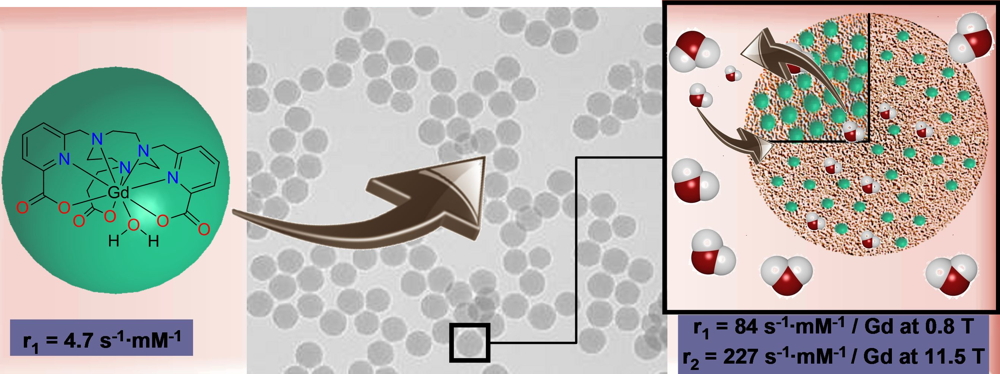MRI is a non-invasive diagnostic tool providing high-resolution anatomical images consisting of 3D maps of the relaxation rates of the hydrogen nuclei in the body. However, its potential for molecular or functional imaging is limited by the low sensitivity of these rates to natural variation between the tissues. Contrast agents, often Gadolinium (Gd) chelates, are administered to enhance the image contrast by increasing the differences between the signals from target tissues and the background. However, the efficiency of commercial contrast agents is still insufficient. Increasing the contrast efficiency, named relaxivity, per-Gd to reach the maximum values predicted by theory1 remains a fundamental challenge.
MR image of a rat brain, 15 minutes after the injection of the contrast product.
M. Mazzanti, P. H. Fries, and their colleagues have reported a new nano-system with exceptionally high per-Gd relaxivity
[2]. Non-covalent confinement of a mono-aqua Gd-chelate into silica nanoparticles (NPs) by a very simple water-in-oil sol-gel synthesis affords a nanosized contrast agent with very high per-Gd relaxivities, exceeding 80s
-1.mM
-1 for r
1 at 0.8T and 227s
-1.mM
-1 for r
2 above 11.5T. These values are about 20 and 50 times larger than those of the free complex and of Gd-based commercial contrast agents for r
1 and r
2, respectively. They are also more than ten times higher than the per-Gd relaxivities previously reported for mono-aqua Gd-chelates covalently grafted to mesoporous silica. Moreover, the high per-Gd relaxivity results in very high per-NP relaxivities for the small (50-60 nm) biocompatible NPs. This efficiency can be assigned to a new type of mechanism where the hindered motion of the outer and inner sphere water molecules inside the NPs together with the permeable nature of silica to water give rise to increased relaxivity.

Noncovalent confinement of a monoaqua Gd chelate into biocompatible silica nanoparticles (NPs; see figure) by a sol-gel method affords a new example of nanosized contrast agents with very high per-Gd relaxivities. Such NPs provide a route to highly efficient multimodal contrast agents.
The versatility of the reported system provides a route to the detailed understanding and optimization of relaxivity. Besides, it allows one to incorporate different chelates,
e.g., with various luminescent and magnetic properties, and tune the NP size and payload. As such, these new NPs are not only highly efficient multimodal contrast agents, but also useful to understand the mechanisms leading to high relaxivities in encapsulating nanosystems.